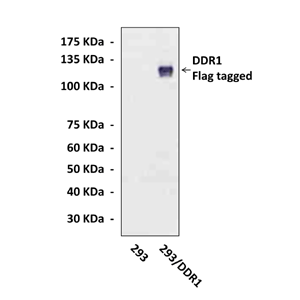Anti-DDR1: Polyclonal Discoidin Domain Receptor 1 Antibody |
 |
BACKGROUND Discoidin domain receptors (DDRs) are a subfamily of transmembrane collagen-binding receptor tyrosine kinases (RTK). DDRs are distinguished from other RTKs by a discoidin domain in their extracellular region, which functions as a lectin in the slime mold Dictyostelium discoideum. There are two genes that code for DDRs in humans, DDR1 and DDR2. Each DDR contains an extracellular region containing the ligand-binding discoidin domain, a stalk region, and a single transmembrane region, as well as a cytoplasmic domain consisting of a juxtamembrane region and a tyrosine kinase domain.1 Expression of DDR1 protein is restricted to epithelial cells, particularly in the kidney, lung, gastrointestinal tract, and brain. Aberrant expression and signaling of DDR1 proteins have been implicated in several human diseases linked to accelerated matrix degradation and remodeling, including tumor invasion, atherosclerosis, and liver fibrosis.2 The activation and autophosphorylation of DDR1 are achieved by treatment of cells with triple-helical collagens.3 DDR1 has been found to play a role in cell attachment, migration, cell survival and proliferation.
REFERENCES
1. Abdulhussein, R. et al: J. Biol. Chem. 283:12026-12033, 2008.
2. Sakamoto, O. et al: Eur Respir J., 17:969-974, 2001.
3. Abdulhussein, R. et al: J. Biol. Chem. 279:31462-31470, 2004.
1. Abdulhussein, R. et al: J. Biol. Chem. 283:12026-12033, 2008.
2. Sakamoto, O. et al: Eur Respir J., 17:969-974, 2001.
3. Abdulhussein, R. et al: J. Biol. Chem. 279:31462-31470, 2004.
Products are for research use only. They are not intended for human, animal, or diagnostic applications.
Параметры
Cat.No.: | CC1016 |
Antigen: | An epitope near the human DDR1 carboxyl terminal sequence. |
Isotype: | Rabbit Polyclonal IgG |
Species & predicted species cross- reactivity ( ): | Human |
Applications & Suggested starting dilutions:* | WB 1:1000 IP n/d IHC (Paraffin) n/d ICC n/d FACS n/d |
Predicted Molecular Weight of protein: | 115 kDa |
Specificity/Sensitivity: | This antibody detects human DDR1 proteins in transfected cell lysate. |
Storage: | Store at -20°C, 4°C for frequent use. Avoid repeated freeze-thaw cycles. |
*Optimal working dilutions must be determined by end user.
Документы
Информация представлена исключительно в ознакомительных целях и ни при каких условиях не является публичной офертой








